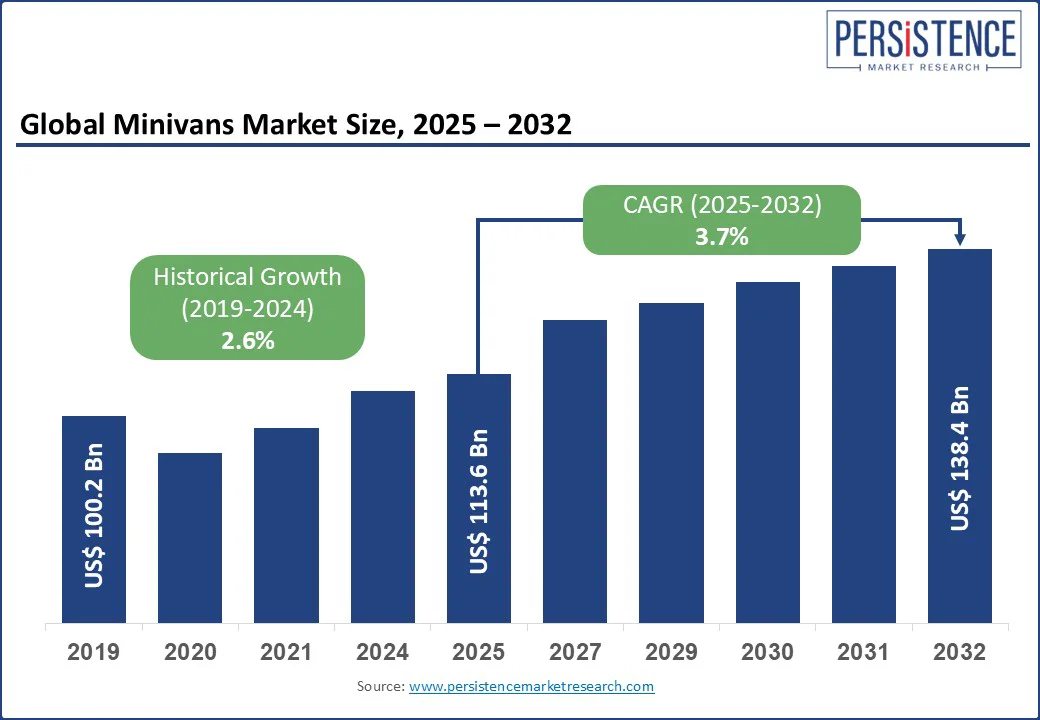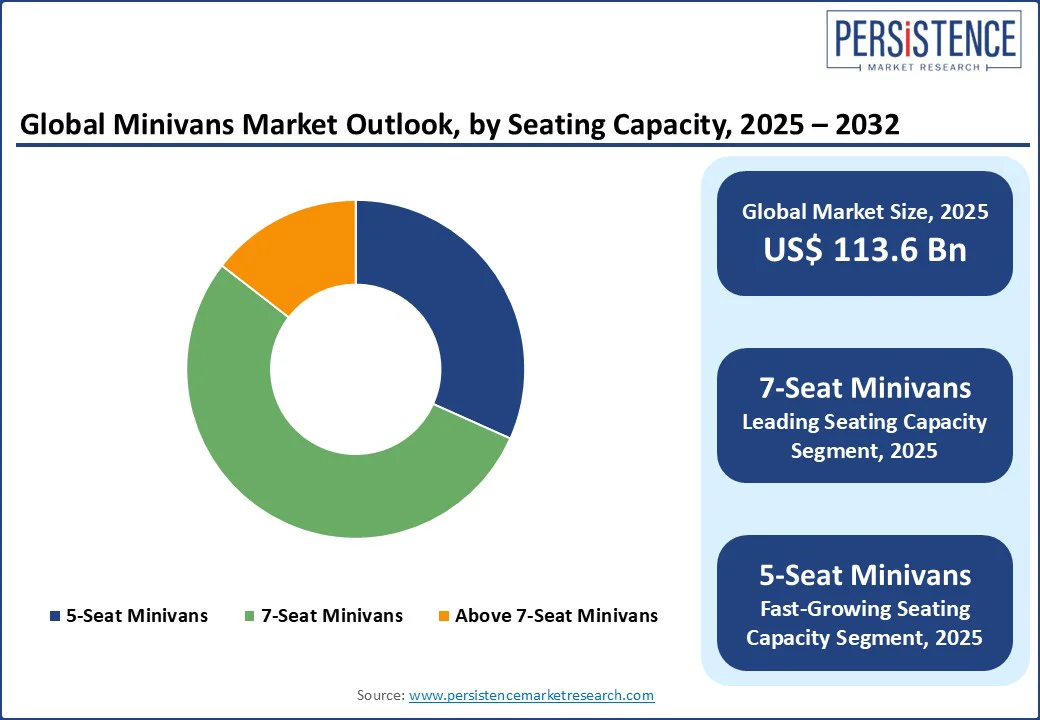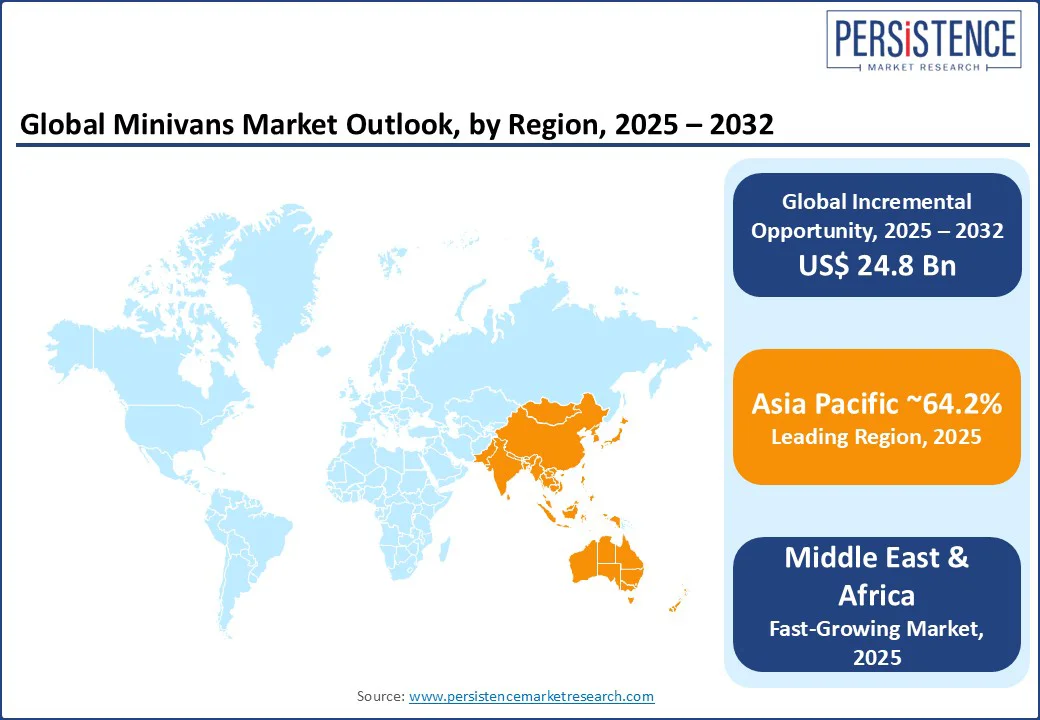ID: PMRREP35537| 189 Pages | 31 Jul 2025 | Format: PDF, Excel, PPT* | Automotive & Transportation

The minivans market size is likely to be valued at US$ 113.6 Bn in 2025 and is estimated to reach US$ 138.4 Bn in 2032, growing at a CAGR of 3.7% during the forecast period 2025-2032. Minivans, once viewed as utilitarian people-movers confined to suburban driveways, are undergoing a strategic repositioning in global mobility markets. Families, fleet operators, and urban mobility providers are gradually shifting toward multi-functional transport solutions. Hence, manufacturers are adopting innovative technologies, alternative powertrains, and modular designs to change the segment’s value proposition. With a rising interest in electrification, connected services, and premium configurations, minivans are evolving from declining legacy assets into purpose-based vehicles.

Key Industry Highlights
|
Global Market Attribute |
Key Insights |
|
Minivans Market Size (2025E) |
US$ 113.6 Bn |
|
Market Value Forecast (2032F) |
US$ 138.4 Bn |
|
Projected Growth (CAGR 2025 to 2032) |
3.7% |
|
Historical Market Growth (CAGR 2019 to 2024) |
2.6% |
Surge in tourism and ride-sharing services is pushing the minivans market growth, specifically in regions where group travel, airport transfers, and intercity mobility require spacious and cost-effective vehicles. In the Middle East, for example, the rise in religious tourism during Hajj and Umrah drives a high demand for multi-passenger vehicles. The growth of platform-based ride-sharing and chauffeur services is further encouraging fleet operators to adopt premium minivans as part of their offerings.
In Southeast Asia, Grab and Indonesia’s Bluebird Group have added models such as the Kia Carnival and Toyota Alphard to their executive transport segments. They usually target corporate travelers and tourists seeking comfort and space. These services have reported higher average trip values for minivan bookings compared to sedans, justifying the investment for fleet owners. Tourism-heavy regions, including Dubai, Bali, and the Turkish Riviera, have also seen a rising demand for chauffeured MPV rentals.
The surging global preference for SUVs and crossovers hampers the adoption of minivans by shifting both consumer perception and manufacturer priorities. Modern SUVs provide comparable interior space, flexible seating configurations, and all-wheel-drive capabilities while projecting a more stylish and rugged image. These attributes often appeal to young buyers and urban families. Automakers have responded by scaling down minivan production or exiting the segment entirely. Ford, for example, officially ceased production of the S Max and Galaxy MPVs at its Valencia plant in April 2023, stating a shift toward electrification and the launch of new EVs.
The trend has led to a self-reinforcing cycle. With fewer minivan options available, buyers have even fewer reasons to consider them. Crossovers have also hindered the family segment by incorporating traditionally minivan-exclusive features. Models such as the Kia Telluride and Hyundai Palisade now offer third-row seating, rear entertainment systems, and ample cargo space. This repositioning has made minivans less relevant for new buyers who no longer see them as the only option for family transport.
The integration of Advanced Driver Assistance Systems (ADAS) and connected car technologies is creating new avenues for minivan manufacturers. They are repositioning these vehicles as high-tech mobility solutions for families, corporate fleets, and commercial operators. New models now come equipped with features such as Level 2 ADAS, adaptive cruise control, lane centering, and surround-view cameras. These make them attractive not only for safe family transport but also for premium shuttle services.
The Volkswagen Multivan T7, for instance, offers Travel Assist, which merges adaptive cruise and lane-keeping into a semi-autonomous highway driving experience. It helps in improving long-distance comfort for both family users and executive transport providers. Connected car platforms are also extending monetization and engagement opportunities. Minivan manufacturers are using these platforms to deliver over-the-air (OTA) updates and subscription-based services, including parental controls and vehicle health reports.
Based on fuel type, the market is divided into diesel, petrol, electric, and others. Out of these, the diesel segment will likely hold around 90.4% of the minivans market share in 2025 due to superior torque, fuel economy, and load-carrying efficiency. In Europe, South Africa, and parts of Asia, where fuel costs are high and usage patterns include highway driving, diesel engines provide a pragmatic solution. While environmental concerns and emissions regulations are pushing some urban centers toward electrification, in regions where infrastructure for EVs is lacking, diesel minivans continue to deliver superior operational savings.
Electric minivans are gaining momentum as governments, fleet operators, and manufacturers focus on reducing emissions in urban mobility and commercial transport. One of the key drivers is the surge in last-mile passenger transport and urban shuttle services. These demand the operational cost savings and regulatory benefits of electric vehicles. Fleet electrification mandates are also pushing large players to adopt electric minivans.
Based on seating capacity, the market is trifurcated into 5-seat minivans, 7-seat minivans, and above 7-seat minivans. Among these, the 7-seat minivans segment is poised to account for nearly 53.8% of share in 2025, backed by changing family mobility requirements, tourism trends, and ride-sharing economics. These cater to both private buyers and intercity cab aggregators who require extra passenger capacity without compromising fuel efficiency or comfort.
5-seat minivans are gaining traction as they bridge the gap between compact cars and large SUVs, primarily in urban markets where space constraints and fuel efficiency are important. These are being adopted in ride-hailing and last-mile logistics applications due to their maneuverability and interior space. The resurgence of 5-seat minivans is also supported by increasing fuel prices and the downsizing trend.

In North America, the minivan has evolved into a niche segment, with total sales shrinking over the past decade due to the rise of three-row SUVs. As per a recent study, in 2023, minivan sales in the U.S. hovered around 350,000 units, down from over 1 Mn in the early 2000s, exhibiting a decline in popularity. However, the segment remains profitable and important for family-oriented automakers. The Chrysler Pacifica led U.S. sales in 2023 with 131,303 units, accelerated by its plug-in hybrid variant. This made it the only minivan offering a PHEV option.
In the U.S. minivan market, Honda sold approximately 71,511 Odyssey minivans in 2023, backed by limited fleet sales and a lack of hybrid options. The Kia Carnival managed to sell nearly 43,600 to 43,700 units in the country, delivering upscale interiors and SUV-like aesthetics at a competitive price point. It attracted crossover buyers who prioritized space and comfort. Minivans in the U.S. have also shifted toward premiumization. Automakers are now focusing on high-margin trims with luxury features, including built-in entertainment systems, power-folding third-row seats, and connected infotainment.
In the Middle East and Africa, minivans maintain a stable presence, augmented by commercial and institutional demand rather than private ownership. In Saudi Arabia, UAE, Egypt, and South Africa, these are widely used for shared transport, airport shuttles, religious tourism, and school services. During Hajj season in Saudi Arabia, for instance, demand for multi-passenger vehicles surges, with models such as the Toyota HiAce and Hyundai H1 commonly deployed by transport operators. Toyota continues to dominate the market, with HiAce leading in fleet sales.
In South Africa, minivans play a key role in the informal minibus taxi sector, which transports an estimated 15 Mn people daily. The Toyota Quantum remains the vehicle of choice, with sustained sales supported by its durability and passenger capacity. Government programs aimed at formalizing and renewing the taxi fleet, such as South Africa’s Taxi Recapitalization Program, have further kept demand for minivans alive. Electrification in the segment remains limited due to infrastructure gaps and cost sensitivity, but interest is emerging.
In 2025, Asia Pacific is expected to account for approximately 64.2% of share due to different cultural and economic dynamics. China, Japan, South Korea, and Indonesia continue to show skyrocketing demand for Multi-Purpose Vehicles (MPVs) and minivans. It is evident in urban and peri-urban areas where large families or business transport requires drive purchases. In China, the segment is evolving with premium electric MPVs such as the Li Auto Mega, which received over 10,000 orders within its first 72 hours. The Mega is aimed at affluent families looking for luxury, space, and EV technology.
In Japan, the domestic market remains loyal to minivans, including the Toyota Alphard and Vellfire, which are often used as executive shuttles and family vehicles. The Alphard, refreshed in mid-2023, saw its popularity rise, with waiting periods stretching over several months due to surging demand. In India and Southeast Asia, minivans remain practical options for middle-class families and shared mobility operators. The Toyota Innova Crysta, often categorized under the MPV umbrella, continues to dominate its class in India. On the other hand, Daihatsu Xenia and Toyota Avanza are the most popular vehicles in Indonesia.

The global minivans market is dominated by a few key players, each striving to generate a high share through innovation, reliability, and novel features. In North America, Chrysler Pacifica has gained impetus by offering the only plug-in hybrid powertrain in the segment. It appeals to environmentally conscious families looking for fuel savings without sacrificing space. The market has significantly contracted in terms of competition, with several automakers such as Ford, Nissan, and GM exiting the segment and focusing instead on SUVs and crossovers. However, this contraction has increased rivalry among the remaining players, pushing them to differentiate through luxury trims, all-wheel-drive options, and tech integrations.
The minivans market is projected to reach US$ 113.6 Bn in 2025.
Rising vehicle ownership among large joint families and high demand for spacious yet compact vehicles in emerging countries are the key market drivers.
The minivans market is poised to witness a CAGR of 3.7% from 2025 to 2032.
Conversions of minivans into electric shuttles and updated smart tourism policies are the key market opportunities.
Stellantis N.V., Nissan Motor Co. Ltd., and Toyota Motor Corporation are a few key market players.
|
Report Attribute |
Details |
|
Historical Data/Actuals |
2019 - 2024 |
|
Forecast Period |
2025 - 2032 |
|
Units |
Value: US$ Bn/Mn, Volume: As Applicable |
|
Geographical Coverage |
|
|
Segmental Coverage |
|
|
Competitive Analysis |
|
|
Report Highlights |
|
|
Customization and Pricing |
Available upon request |
By Fuel Type
By Seating Capacity
By Application
By Sales Channel
By Region
Delivery Timelines
For more information on this report and its delivery timelines please get in touch with our sales team.
About Author